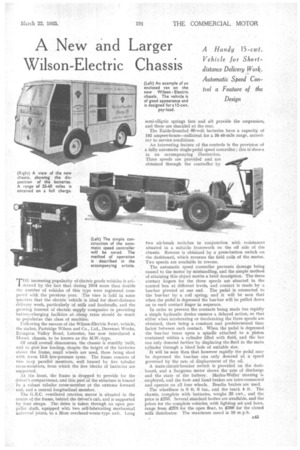A New and Larger Wilson-Electric Chassis
Page 59

If you've noticed an error in this article please click here to report it so we can fix it.
TMITE increasing popularity of electric goods vehicles is evi1 denced by the fact that during 1934 more than double the number of vehicles of this type were registered compared with the previous year. •The view is held in some quarters that the electric vehicle is ideal for short-distance delivery work,. particuIaely of milk and foodstuffs, and the growing interest of electric supply companies in providing battery-charging facilities at cheap rates should do much to popularize this class of machine.
Following the success of the Wilson-Electric 8-cart. vehicle, the maker, Partridge Wilson and Co., Ltd., Davenset Works, Evington Valley Road, Leicester, has now introduced a 15-cwt. chassis, to be known as the M.W.-type.
Of small-verall dimensions, the chassis is sturdily built, and to give low loading, despite the height of the batteries above the frame, small wheels are used, these being shod with Avon 1345 low-pressure tyres. The frame consists oftwo deep parallel members, well braced by five tubular cross-members, from which the five bioCkS of batteries are supported.
At the front, the frame is dropped to provide for the driver's compartment, and this part of the structure is braced by a robust tubular cross-member at the extreme forward end, and a central longitudinal member.
The G.E.C. ventilated traction motor is situated in the centre of the frame, behind the driver's ca.b, and is supported by tour straps. The drive is taken through an open pro-puller shaft, equipped with two self-lubricating mechanical universal joints, to a Moss overhead-worm-type axle. Long two air-break switches in conjunction with resistances situated in a suitable framework on the off side of the chassis. Reverse is obtained by a press-button switch on the dashboard, which reverses the field coils of the motor. Two speeds are available in reverse.
The automatic speed controller prevents damage being caused to the motor by mishandling, and the simple method of attaining this object merits a brief description. The three contact fingers for the three speeds are situated in the control box at different levels, and contact is made by a bus-bar pivoted at one end. The pedal is connected to the bus-bar by a coil spring, and it will be seen that when the pedal is depressed the bus-bar will be pulled down on to each contact finger in sequence.
In order to prevent the contacts being made too rapidly a simple hydraulic device ensures a delayed action, so that either when accelerating or decelerating the three speeds are obtained, there being a constant and predetermined time factor between each contact. When the pedal is depressed the bus-bar bears upon a spindle attached to a piston contained within a cylinder filled with fluid, and the bar can only descend further by displacing the fluid in the main cylinder through a bleed hole of suitable size. It will be seen then that however rapidly the pedal may be depressed the bus-bar can only descend at a speed governed by the rate of displacement of the oil.
A main-circuit-breaker switch is provided on the dash board, and a Sangarno meter shows the rate of discharge and the state of the battery. Marks-Weller steering is employed, and the footand hand-brakes are inter-connected and operate on all four wheels. Bendix brakes are used. The wheelbase is 6 ft. 6 ins., and the track 4 ft. The chassis, complete with batteries, weighs 25 cwt., and the price is £255. Several standard bodies are available, and the prices for the complete vehicles, with lighting set and horn, range from £278 for the open float, to ENO for the closed milk distributor. The maximum speed is 20 mph.




























































































